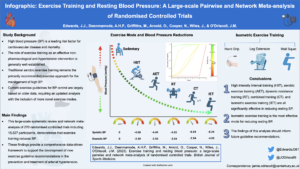This blog provides an overview of a study recently published in BJSM. Please click here to access the full article.
Why is this study important?
It is estimated that more than 1.4 billion of the world’s population has high blood pressure (hypertension), which is a leading cause of disease and death. Commonly prescribed medications to treat high blood pressure carry a number of substantial limitations including negative side effects, considerable economic costs and poor adherence rates. As such, alternative non-pharmacological approaches, such as exercise training, are largely favoured.
Based on previous research, traditional aerobic exercise training consisting of 150-minutes of at least moderate intensity continuous exercise performed over the course of a week remains the primarily recommended approach for blood pressure control. However, these recommendations are largely based on historical data, and recent investigations have provided evidence to demonstrate that novel exercise modes, such as high intensity interval training and isometric (static) exercise training may provide greater improvements in blood pressure control. As a consequence, the optimal exercise intervention for the management of resting blood pressure is unknown, which will impact exercise guideline recommendations at a population level.
We therefore aimed to perform an updated large-scale pairwise and network meta-analysis on the effects of all relevant exercise training modes on resting blood pressure to establish optimal anti-hypertensive exercise prescription practices.
How did the study go about this?
We performed a comprehensive systematic search of all randomised controlled trials that reported systolic (sBP) and/or diastolic (dBP) blood pressure changes following an exercise intervention ≥2 weeks with an eligible non-intervention control group. Training protocols were broken down into the following primary exercise mode categories for comparison: Aerobic Exercise Training, Dynamic Resistance Training, Combined (Aerobic with Dynamic Resistance) Training, High Intensity Interval Training and Isometric Exercise Training. Each category was then further explored for sub-groups, allowing for the secondary analysis of Walking, Running, Cycling, Sprint Interval Training, Aerobic Interval Training, Isometric Handgrip, Isometric Leg Extension and Isometric Wall Squat exercise training.
Independent pairwise analyses were performed on all primary and secondary exercise modes. Each primary pairwise analysis was then further analysed according to baseline blood pressure. Separately, to facilitate the comparison of exercise modes that have not been directly compared in head-to-head randomised controlled trials, all modes were analysed collectively in Bayesian network meta-analyses. Additional moderator and sensitivity analyses were also performed during analysis.
What did the study find?
270 randomised controlled trials were included in the final analysis, with a pooled sample size of 15,827 participants. Pairwise analyses demonstrated significant reductions in resting sBP and dBP following aerobic exercise training (-4.49/-2.53mmHg, P<0.001), dynamic resistance training (-4.55/-3.04mmHg, P<0.001), combined training (-6.04/-2.54mmHg, P<0.001), high intensity interval training (-4.08/-2.50mmHg, P<0.001) and isometric exercise training (-8.24/-4.00mmHg, P<0.001).
The network meta-analyses rank order of effectiveness based on the surface under the cumulative ranking curve (SUCRA) values for sBP were isometric exercise training (SUCRA: 98.3%), combined training (75.7%), dynamic resistance training (46.1%), aerobic exercise training (40.5%) and high intensity interval training (39.4%). Secondary network meta-analyses revealed isometric wall squat and running as the most effective sub-modes for reducing sBP (90.4%) and dBP (91.3%) respectively.
What are the key take-home points?
Aerobic exercise training, dynamic resistance training, combined training, high intensity interval training and isometric exercise training are all significantly effective in reducing resting sBP and dBP. However, isometric exercise training is the most effective mode. The types of isometric exercises analysed in this work include a wall squat, handgrip squeeze or leg extension, often performed in 3 sessions per week consisting of 4 x 2-minute intervals, separated with 2-minute rest periods between each set. These findings provide a comprehensive data-driven framework to support the development of new exercise guidelines for the prevention and treatment of high blood pressure.
Author information:
Jamie J Edwards
Jamie M O’Driscoll
